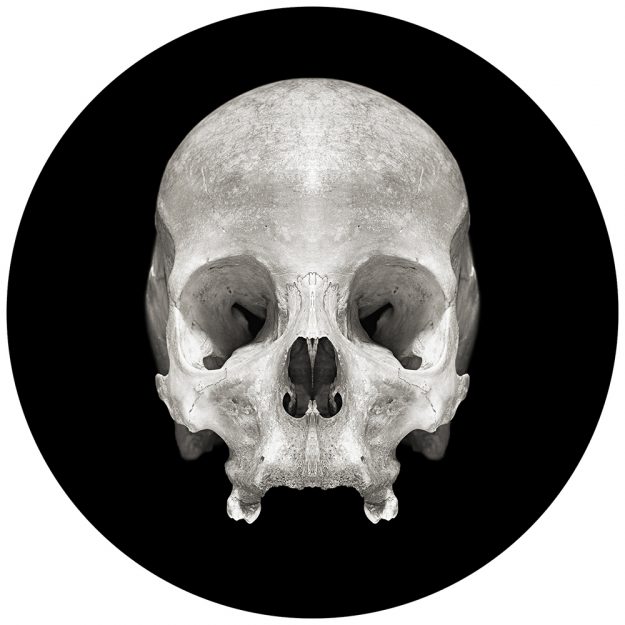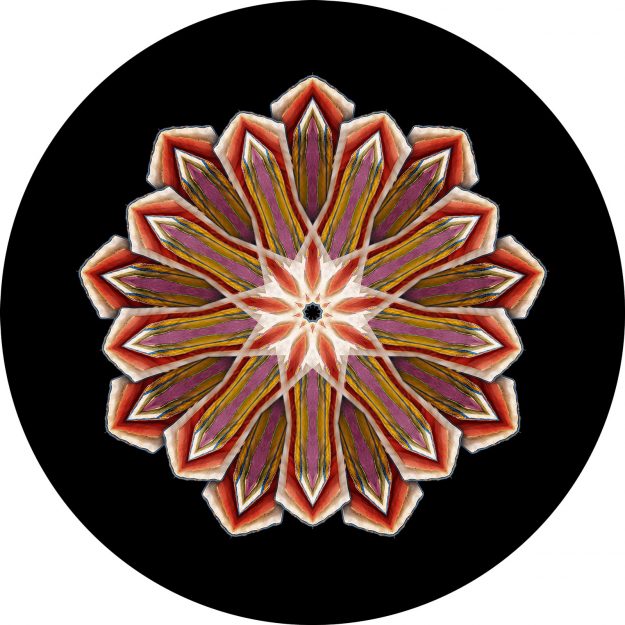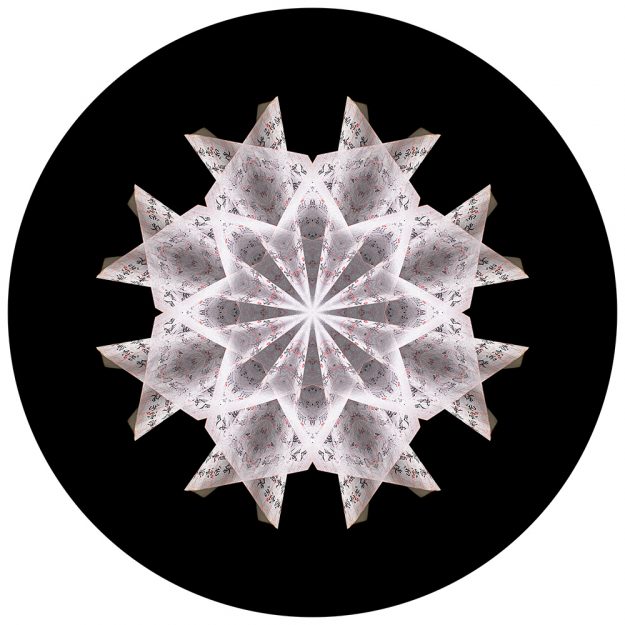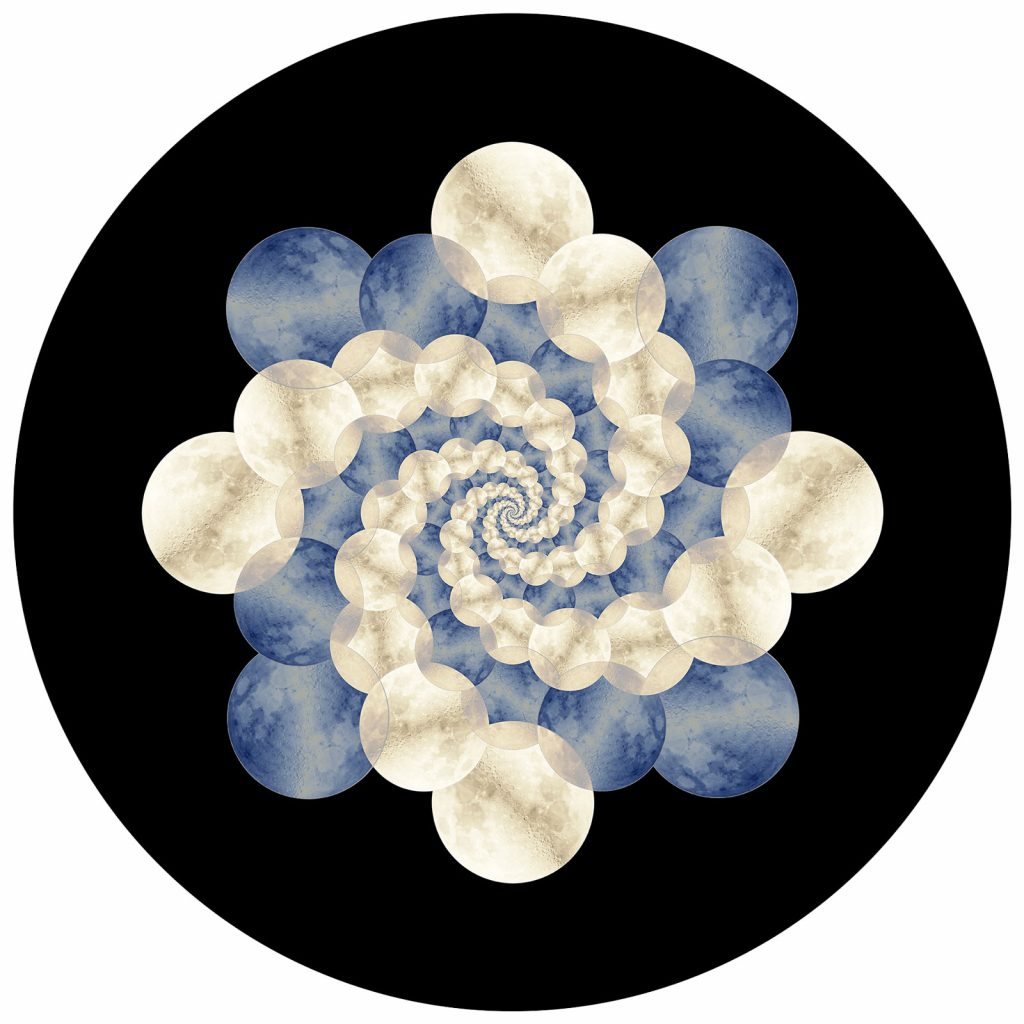Artist David Orr’s new exhibition, Radiance + Reflection: Mandalas and Moon marks the first in-person art opening at New York City’s Tibet House since the beginning of the pandemic. The New York-born, Los Angeles-based artist’s exhibit explores “symmetry, themes of interconnection, impermanence, and the way we apply order.”
“Tibetan Buddhism already revels in the visual, which is appealing to any artist,” Orr writes in the exhibit’s catalog, “but the connection for me goes far deeper.” He draws artistic inspiration from Thich Nhat Hanh’s idea of Interbeing—that, “The one can be seen in the all, and the all can be seen in the one.”
In keeping with this notion, the exhibit consists of three distinct yet interconnected series of mandalas. First is “Perfect Vessels,” a series of photographs of human skulls originally shot at the Mütter Museum of Pathology in Philadelphia. Orr has digitally reconstructed the photographs to give the skulls, marked by disease and imperfection, a symmetrical appearance. “I liked the idea that, simply by repeating these ‘imperfections,’ I achieved results closer to perfection,” Orr writes.

The skulls-as-vessels dot the walls of the hallway leading into the main exhibit hall, where the “Mandala Lunae” and “Illumined” series take center stage. Like “Perfect Vessels,” these two sequences are inspired by the form of the mandala. In keeping with the word’s Sanskrit definition—“circle”—each work is mounted onto a uniformly-sized round aluminum disc. Looking at both “Mandala Lunae” and “Illumined,” the viewer’s eye traverses complex geometric patterns, ultimately landing in the blank, void-like reflective space at the center of the aluminum disc. In this way, the viewing experience itself enacts the principle “emptiness is form, form is emptiness” from the Heart Sutra.
Orr says: “A circle has consistently been the [geometric form] most chosen when representing complex information, from the earliest known celestial depictions to particle probability diagrams used in quantum physics,” adding that “which universe is being depicted depends on the series.” As Chogyam Trungpa writes in Orderly Chaos: The Mandala Principle: “Mandala is that which is contained in everyday life. That includes the animate and inanimate, form and the formless, emotion and non-emotion. Wherever there is relationship, that seems to be the mandala principle.”
While Buddhism is an ongoing interest of Orr’s, he takes a playful approach to his study and practice, valuing creative inspiration and exploration over mastery. He finds meaning in the process itself: “I’m always fascinated by the concept of ‘be here now’ because… I’m never ‘here now,’” Orr told me when I visited the exhibit.
During the 2020 lockdown, a close friend of the artist’s gifted him a telescope, and he began capturing images of the moon from his Los Angeles backyard. He didn’t realize then that these images would become the raw material for the “Mandala Lunae” series at the center of “Radiance + Reflection.” Originally, he simply shared them with friends via an email list, wanting to “uplift the spirit of friends and family” during a difficult time.
“I take comfort in the fact that whether seen by friends in America, Australia, France, Holland, India, New Zealand, Russia, the UK, etc. — if we look up at night we’re all seeing the same moon, in its same phase,” Orr says. “I see the moon as a reminder of how disparate lives are interwoven.” The moon project is an “ongoing practice” for Orr. With over thirty images accumulated already, Orr will continue each week until the year is complete. (Anyone can sign up for Orr’s free Mandala 4 Monday email listserv).

The repeated sequence of circles around the room subtly resembles a mala—a string of beads used to enhance meditative contemplation, named after the Sanskrit word for garland. Incidentally, Orr also cites as inspiration the Flower Garland Sutra, which describes “untold moons” emitting “untold beams of light” as they emanate from the body of the Buddha.In the sutra, “a cosmos of infinite realms upon realms, mutually [contain] each other.”
The moon, besides appearing in all different types of mythology throughout history, also has “a powerful influence here on earth and the way we measure time,” Orr says, pointing out the fact that the words moon and month share a common linguistic root.
Interspersed among the lunar mandalas is a third body of work wherein Orr has created mandalas using images of sacred manuscripts, texts, and sutras that he accessed during a residency at the Los-Angeles-based Philosophical Research Society—where the C.J. Jung, Aldous Huxley, and other esoteric philosophers once spent time. “I had to be extremely careful,” Orr told Tricycle of his process in a 2018 article on an earlier iteration of the exhibit. “I didn’t want to be the guy who cracked a thousand-year sutra.”

The “Illumined” series draws from an eclectic tradition of esoteric texts—from a typewritten 1888 manuscript from Helena P. Blavatsky featuring hand-colored diagrams, to a silk-paneled Prajnaparamita Sutra manuscript and an 1834 Lotus Sutra manuscript from the collection of Japanese priest Joyen.
Orr manipulated the images of the manuscripts to create abstract, yet symmetrical, compositions. One has to look closely to see any legible words, if they exist at all, in the final form. While the appearance of the manuscripts have been altered, Orr points out that the transformation reflects the Daoist principle that “the deepest truths can never be captured by words alone.” So, Orr says, “the language in each manuscript that I photograph creates a discrete conceptual model of the universe; an intricate, multifaceted construction of thought.”
“I’m preoccupied by order and pattern. How we seek and create it. Whether or not we’ve uncovered an existing order or simply imposed our own structures over systems we don’t yet fully comprehend,” Orr writes. “As a result, I have been drawn to areas where philosophy, science, and art interact. That seems where truth is most likely to reside.”
Thank you for subscribing to Tricycle! As a nonprofit, we depend on readers like you to keep Buddhist teachings and practices widely available.
